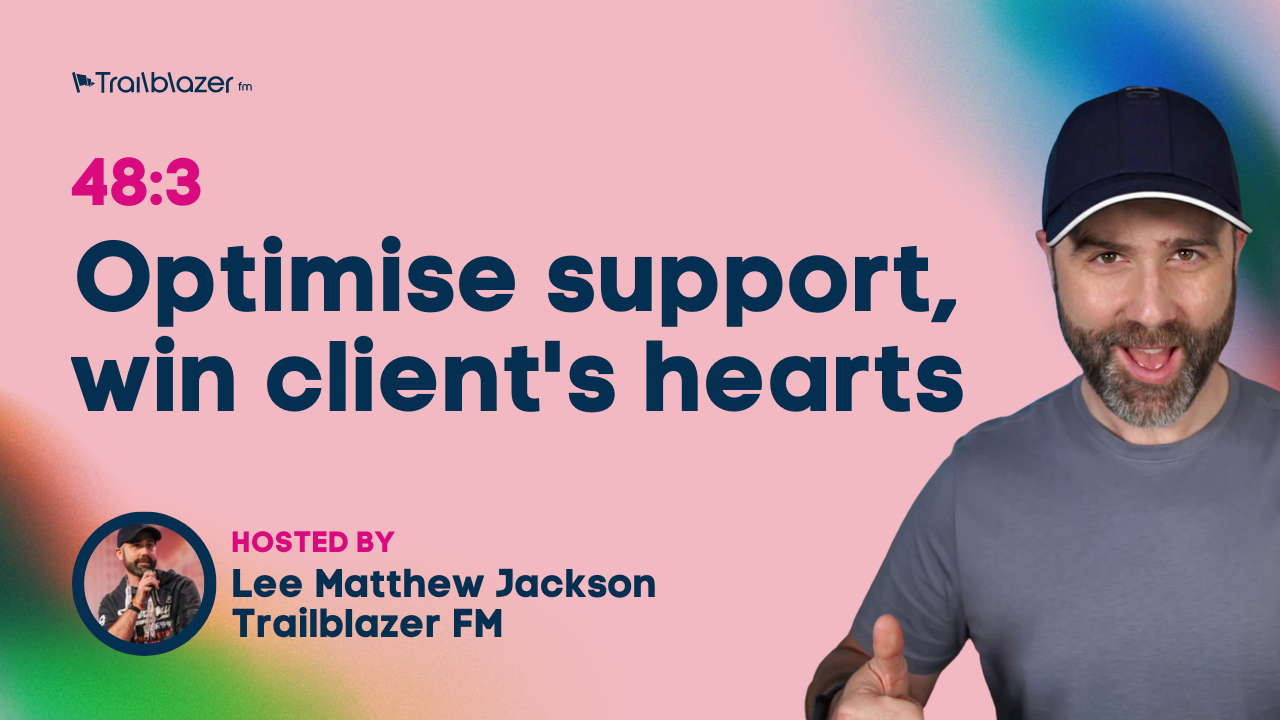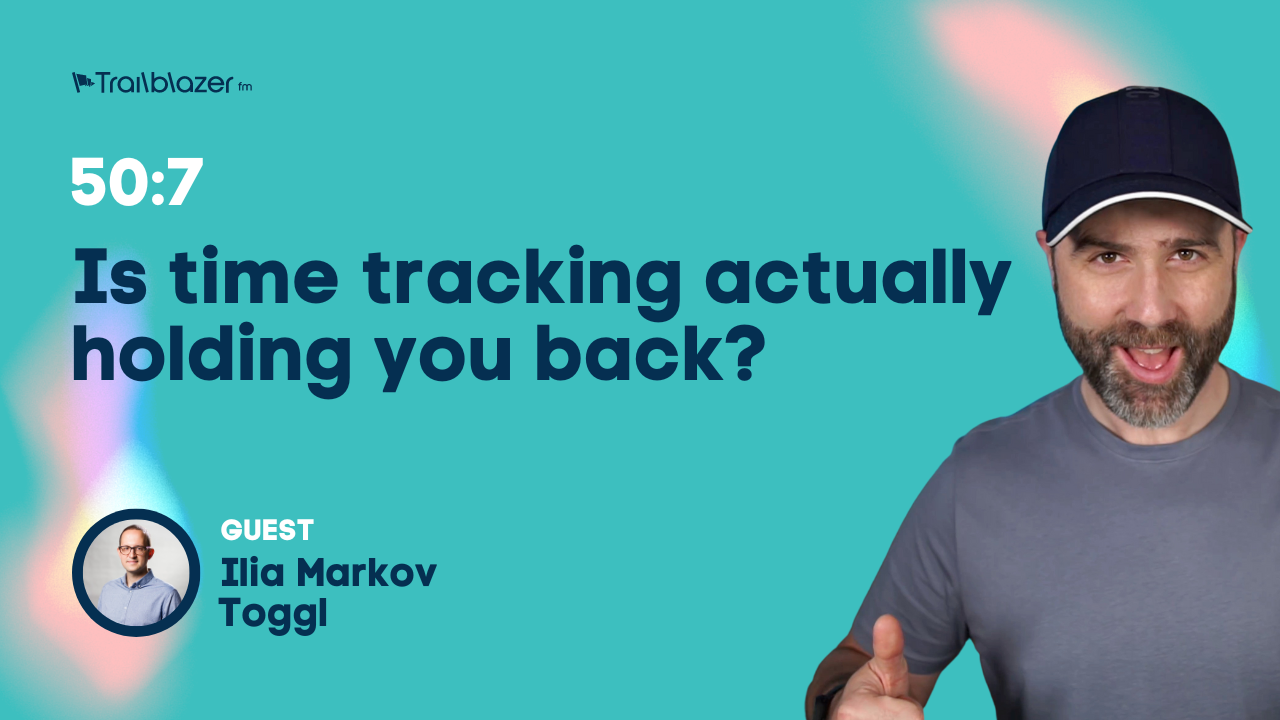
48:3 Optimise support, win client's hearts
Unlock the secret to streamlined support and proactive client communication.
Are you having a tough time providing top-notch support to your clients? In this episode, Lee spills the beans on how his agency, Event Engine, turned their messy support system into one with a perfect 100% client happiness rating.
Discover the super simple process they put in place to bring order to their support system, improve communication, and take a more proactive approach to helping their clients.

Grab a notebook and pen, find a quiet place, and get ready to revamp your own support workflow!
The lowdown
Keeping it super simple, here's the workflow in 7 sentences!
- Make it a breeze for clients to reach you and show them the ropes.
- Bring everything together with a centralized helpdesk system.
- Pair up support requests with the perfect team member.
- Keep clients in the loop as their request gets handled.
- When needed, bring in the big guns (senior colleagues) to tackle tough issues.
- Make sure clients are all smiles before wrapping up the ticket.
- Keep an eye on support requests to level up your proactive support content.
Quick takeaways
Key takeaways from this week's episode. Let us know yours in the comments below.
- A centralized support system helps everyone stay on the same page.
- Regular updates keep clients feeling cared for and in the know.
- Being proactive can really cut down on the number of support requests.
- Stay on your toes and keep tweaking your products and services to meet clients' needs.
Tools
Some helpdesk platforms to pique your interest:
- Help Scout - https://www.helpscout.com/
- Zendesk - https://www.zendesk.com/
- Freshdesk - https://freshdesk.com/
- Intercom - https://www.intercom.com/
- Zoho Desk - https://www.zoho.com/desk/
Jump in the comments below and join the chat, and please share this episode with your friends or on social media to help us reach even more listeners. Catch you in the next episode!
Transcript
Welcome to the Trailblazer FM podcast. This is your host Lee, and in today's show, we're gonna be talking about supporting our clients.
My agency Event Engine has recently been looking at our data, and we are very proud that our happiness rating is currently at 100%. Basically, we receive tickets and at the end of the ticket, when it's closed, a little survey is sent to our clients and they will click on whether they are happy, neutral, or sad.
So we are very proud to have a 100% rating. And in today's episode, I wanna share with you folks how we have achieved it. And yes, as per our previous episodes, our process is ridiculously simple.
The thing is, it's not always been that way. And if we jump into a time machine, just a few years ago, our support was abysmal. We had no centralized place for support. We did have a support email, but unfortunately, we had clients emailing different people within our team with different support requests.
We didn't know who was working on what and we were very often overwriting each other's fixes. We were also very often losing our place and forgetting who had asked what of whom and who was doing what, and I'm even finding this sentence completely confusing to share because it was just a hot mess. In fact, I would often be sent an email maybe two or three weeks after the original request with someone saying, "Hey, well what's the update on this? Or perhaps I'd even get one of my team members coming over to me saying, "Lee, I've just had our client on the phone and they are fuming".
Now you can imagine the end result of this was we lost clients. If you cannot provide good support, you are going to lose the trust and the faith of your clients, and eventually they are gonna vote with their feet and they're gonna leave for an alternative.
So now I'm gonna share with you what we did, and just like previous episodes, it is extremely simple. We will bullet this in the show notes, so it's very easy to follow. And there'll also be a list of tools that you can check out and pick the one that best suits your workflow.
So the first thing we did was make it really easy for our clients to contact us and ensure that we educated them on how to do it. Like I said, in the past, people were emailing different members of the team, so we centralized everything into a support email, so that was support @ our agency. We made sure those emails then went into a help desk system. We also gave them the option to submit a support request via our website, which again would go into the support system.
Because we use Help Scout, we were also able to add a widget into the WP admin of the sites that we supported, and clients were able to submit tickets from there, which gave us loads of extra information automatically. Now that it's easy for clients to get in touch, we need to make sure that we've got that in one central place rather than in everybody's inbox.
Like I said, for us, we chose to use Help Scout. We've dropped a list of alternative help desks for you in the show notes for you to check out as well. Essentially, without implementing something like Help Scout, then we wouldn't be able to deliver on the rest of our process.
Next, we will use Help Scout to match an incoming support request with the right team member. We have a broad team of various skills and of course availability. So when a ticket comes in, I'm going to be assigning something that needs someone to get knee-deep in code to my colleagues such as Karthi. If it's something to do with the servers, I might be assigning that to Barath or to Ed. If it's a content-related issue, then Priya may be picking this up. And the great thing is once I've assigned the ticket to the relevant person, they're gonna be notified that there is a ticket waiting for them to go ahead and check out.
Now that the ticket has been assigned to somebody, it's their responsibility to communicate with the client regularly. Not only should they be looking to resolve the issue as quickly as possible, but no matter how long it takes, they should be giving updates. In most circumstances, it's a quick fix and it's a quick reply. Thumbs up, everybody's happy.
However, quite often a ticket may take one or two days if it requires some sort of research or if it requires some extra activity from the client or some more information. So we ask whoever is responsible for the ticket to communicate with the client every 24 hours that's in working days to ensure that it continues. We also have an automation that if a ticket hasn't had any activity on it for 24 hours, it'll actually be escalated to another team member to check in on that. So that helps us keep accountable to the rest of the team.
Speaking of escalation and allocation, the next step for a ticket. If it's something that our first line of defense cannot resolve, then it will get escalated to one of our more senior colleagues who may have to take over and try and get the ticket resolved. So again, we can do that from within the system.
And finally, when a ticket has been completed, we won't close it straight away. We'll respond to the client with all of their relevant information and we'll ask them to test it. If they respond, giving us a thumbs up, we will still keep that ticket open for another working day or two just to be sure that everything is all right before we close that ticket. Sometimes something might crop up and it's never great to close a ticket prematurely if you can just jump in and fix something else that may have cropped up.
Once the ticket's closed, that is when that email goes out. The great thing about using a help desk system is it allows you to automate things like these reminders and also those emails that are triggered either internally to tell you that a ticket has been escalated or externally that triggered email at the end of a ticket being closed and getting some of that feedback.
Now, all of this is the reactive support process. We've also improved our support beyond that by being proactive. I mentioned earlier that we have a small widget in the backend of people's websites where they can submit a ticket, but also within that is an entire knowledge base. That's actually to stop them even having to submit a ticket.
They can start to type in what their problem is and be served with an article that might help them do what it is they need to do. For example, in the past, people were trying to work out how to make their website a little bit more responsive, and we created an article on that along with a video how-to guide, and all of the tickets that used to come in on that all disappeared. It's wonderful. We also have a URL that we sent to clients that have all of this knowledge base available to them.
Also, because we have the help desk system, we can look at the sorts of tickets that are being raised. If there's a regular type of ticket being raised, then yes, we can create some content to support that versus mitigate the need for people to open a ticket. But equally, there may be tickets to do with the performance or the speed of our product, or perhaps the usability. If we see regular tickets like that, then perhaps there is scope for us to improve our platform, improve the usability, thus we are proactively avoiding future tickets like that. We're solving their issues in advance and removing the requirement for them to have to come and complain.
Looking back all those years ago when we didn't have a centralized system, when we didn't have this simple process, we essentially didn't have a visual on what was going on, and we couldn't be very reactive, nor could we be proactive at all. So there you have it. Make it easy for your clients to get in touch and make sure you educate them on how to and what information they can give you to make it as easy as possible for you to support them.
Implement a centralized location for all of this, such as Help Scout. Check out the show notes for a link of other alternatives. Once that ticket comes in, match that support request to the right team member based on their skill and availability. Throughout the process, keep your clients informed of how it's going.
Make sure you escalate anything if you need further help. Once you've resolved the ticket, hang on for a few days to make sure that the client is definitely happy. Then close that ticket. Make sure you get that feedback and continue to monitor all of the requests that you get over time so that you can continue to improve your proactive support content.
There you have it. Nice and simple. So, what platform do you use to support your clients? Let us know in the comments. Just click on the link in the show notes of your podcast player. Scroll down to the comments section. Sign up. And get involved in the conversation. If you've had some value from this episode, can I encourage you to share it with a friend or maybe even share it on social media?
As I've shared in past episodes, we are only using social media nowadays as a broadcast mechanism, such as a newsfeed, simply because for me personally, I just don't want to spend too much time on social media anymore. I've got a small family, and I just want to spend loads of time with them. So if I could ask you that favor, I've given you some time on this podcast. If you've had some value, please share it. That would be absolutely amazing, and that will help us grow this show and get into the earbuds of many people to come in the future. So thank you so much. So folks, if we don't see you in the comments, then how about we see you in the next episode?








